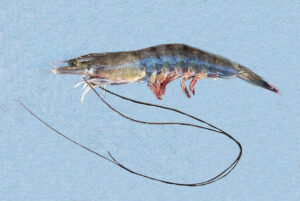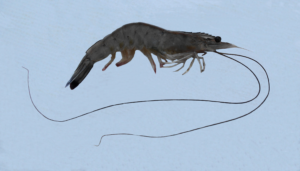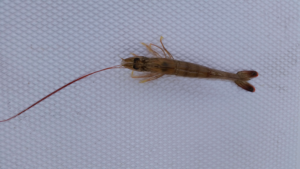Blue Shrimp, Penaeus stylirostris
 Blue Shrimp, Penaeus stylirostris. Shrimp netted from within the estuary of Puerto Adolfo Lopez Mateos, Baja California Sur, December 2021. Length: 24 cm (9.5 inches). Photograph courtesy of Brad Murakami, Surrey, British Columbia, Canada.
Blue Shrimp, Penaeus stylirostris. Shrimp netted from within the estuary of Puerto Adolfo Lopez Mateos, Baja California Sur, December 2021. Length: 24 cm (9.5 inches). Photograph courtesy of Brad Murakami, Surrey, British Columbia, Canada.
 Blue Shrimp, Penaeus stylirostris. Shrimp caught with a cast net off the pier in Puerto Adolfo Lopez Mateos, Baja California Sur, August 2018. Length: 25 cm (9.8 inches).
Blue Shrimp, Penaeus stylirostris. Shrimp caught with a cast net off the pier in Puerto Adolfo Lopez Mateos, Baja California Sur, August 2018. Length: 25 cm (9.8 inches).
 Blue Shrimp, Penaeus stylirostris. Shrimp caught with a cast net from coastal waters off Loreto, Baja California Sur, May 2019. Tentative identification. Catch and photograph courtesy of Chris Wheaton, Fullerton, California.
Blue Shrimp, Penaeus stylirostris. Shrimp caught with a cast net from coastal waters off Loreto, Baja California Sur, May 2019. Tentative identification. Catch and photograph courtesy of Chris Wheaton, Fullerton, California.
Phylogeny: The Blue Shrimp, Penaeus stylirostris (Stimpson, 1871), is a member of the Penaeidae Family of Penaeid Shrimps. This species is also known as the Pacific Blue Shrimp, Western Blue Shrimp, and in Mexico as camarón azul.
Morphology: The Blue Shrimp is light blue to white in color. The lateral grove along both sides of the rostrum is slight or absent. Blue Shrimp reach a maximum of 27.5 cm (10.75 inches) in length with the carapace having a maximum length of 5.9 cm (2.3 inches).
Habitat and Distribution: The Blue Shrimp are found in brackish waters with temperatures around 25oC (77oF), benthic mud and sand substrate in bays and coastal lagoons where they are often associated with mangrove trees, between 5 m (16 feet) and 45 m (147 feet) deep. Juvenile shrimp generally live in estuaries, lagoons, and coastal waters before migrating offshore to deeper waters at depths up to 115 m (377 feet)) to reproduce and complete their life cycle. The Blue Shrimp is a resident of all waters of the Pacific with the exception that they are absent from north of Guerrero Negro, Baja California Sur. I have personally seen these caught within the estuary in Puerto Adolfo Lopez Mateos.
Diet and Life Cycle: The Blue Shrimp are bottom feeders, feeding on worms, shrimp, and mollusks. In turn, they are preyed upon by crabs, fish, and larger shrimp. They have short live spans reaching sexual maturity quickly, high fecundity, and are high resiliency to overfishing. However, their populations are very sensitive to temperature changes and high salinities.
Economic Importance: The Blue Shrimp is the most abundant shrimp species in the Mexican Pacific, with major commercial catches in the states of Sinaloa and Sonora. When sold commercially, they are mixed in with the Brown Shrimp, Penaeus aztecus and the Pacific White Shrimp, Penaeus vannamei to be collectively sold as “Mexican White Shrimp.” They represent one of the most economically important fisheries in Mexico with 60,000 tons sold annually and large amounts of discarded by-catch (catch to by-catch ratios being 1:9 on average). Most are exported whole, frozen in 5 lb boxes called “marquetas”. The small to medium sized shrimp are sold fresh or frozen. They are caught with bottom trawlers in offshore locations which is highly destructive to the habitat and produces a high level of by-catch. They are heavily regulated by the Mexican Government with annual quotas and seasonal bans in place to protect spawning areas. They are plagued by a lack of stock assessment and overall management and thus are prone to illegal catch. The Blue Shrimp is also resides within Magdalena Bay, Baja California Sur where they are only fished by unregulated unmonitored artisanal fishermen utilizing cast nets, gill nets, suripera nets, and small trawls that have a minimal impact on the environment and have low levels of by-catch. When available they are often used by recreational anglers as an exceptional live bait, targeting a wide variety of fish.
Conservation: From a conservation perspective the Blue Shrimp has not been formally evaluated, however, they are subject to overexploitation and their long-term viability is currently of concern. Efforts to propagate this species via aquaculture suffered a major set-back in the 1980s as the IHHN virus destroyed most of their stocks. New IHHN resistant stocks were developed with farming reaching the 17,000-ton level in 1998 but then become economically unsustainable and dropped to current levels of 2,000 tons per year. They are capable of surviving low water temperatures but require high oxygen levels, protein levels, salinities, and turbidity. They are famous for being escape artists.
Synonyms: Litopenaeus stylirostris.